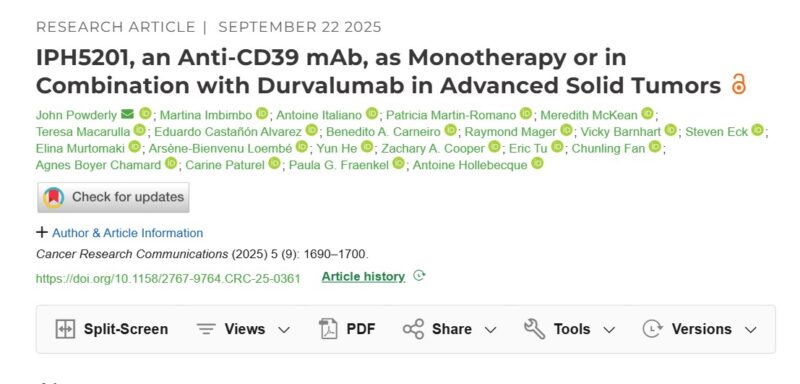Italiano Antoine, Head of Precision Medicine at Gustave Roussy, shared on LinkedIn about a recent paper by John Powderly et al. published on AACR Journals:
“Targeting CD39 in Cancer: Promise (?) and Persistent Challenges
Metabolism sits at the heart of cancer–immune interactions. Tumor cells reshape metabolic pathways not only to fuel their growth, but also to suppress effective immune responses. Among these, the adenosine pathway is one of the most powerful brakes on antitumor immunity. By converting ATP into AMP, CD39 drives adenosine production and shapes a profoundly immunosuppressive tumor microenvironment.
In our recently published first-in-human phase 1 trial of IPH5201 (anti-CD39 mAb, alone or with durvalumab), we observed:
- Pharmacologic activity with reduced intratumoral CD39 enzymatic function
- Manageable safety profile
- Disease stabilization as the main clinical signal
But the study also underscores the core challenge: consistent clinical efficacy has been elusive. Despite strong biological rationale, CD39 blockade as monotherapy has not yet translated into durable responses.
Patient selection is a critical hurdle. Biomarkers explored so far include:
- CD39/CD73 expression levels on tumor and immune cells, linked to hypoxia and worse prognosis in NSCLC (Giatromanolaki A, et al. Life Sci. 2020;259:118389. PMID: 32898522).
- Adenosine gene signatures, which correlate with a suppressive tumor microenvironment and poor outcomes, and may help define ‘adenosine-high’ tumors (Sidders B, et al. Clin Cancer Res. 2020;26:5628-5638. PMID: 31953314).
- On-treatment biopsies, where we confirmed pharmacodynamic activity of IPH5201 by showing reduced CD39 enzymatic activity – though this has not yet predicted clinical benefit.
Other agents in the pathway show a similar story.
Take-home message: To unlock the promise of CD39 and the broader adenosine axis, we need robust biomarker strategies to identify the right patients – and rational combinations (PD-(L)1 blockade, immunogenic chemotherapy) to convert pharmacodynamic activity into durable clinical benefit.
The key question: which patients truly have ‘adenosine-driven’ tumors, and how do we select them?”
Title: IPH5201, an Anti-CD39 mAb, as Monotherapy or in Combination with Durvalumab in Advanced Solid Tumors
Authors: John Powderly, Martina Imbimbo, Antoine Italiano, Patricia Martin-Romano, Meredith McKean, Teresa Macarulla, Eduardo Castañón Alvarez, Benedito A. Carneiro, Raymond Mager, Vicky Barnhart, Steven Eck, Elina Murtomaki, Arsène-Bienvenu Loembé, Yun He, Zachary A. Cooper, Eric Tu, Chunling Fan, Agnes Boyer Chamard, Carine Paturel, Paula G. Fraenkel, Antoine Hollebecque

More articles from Italiano Antoine.


